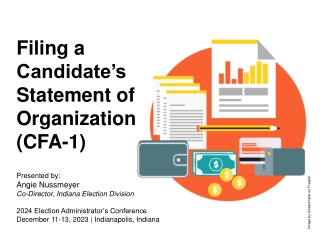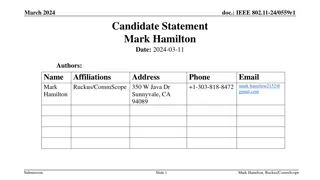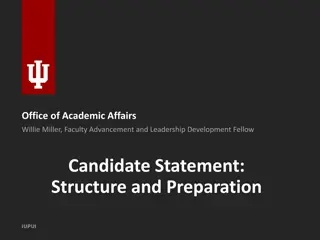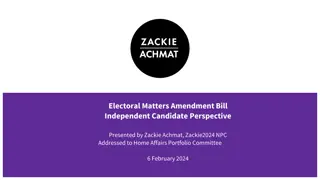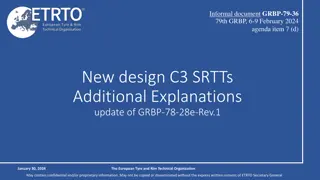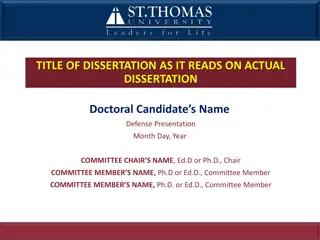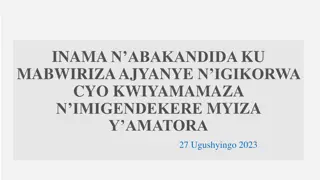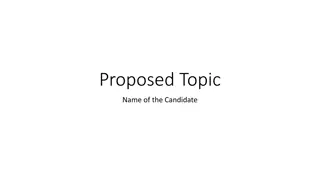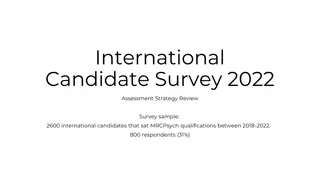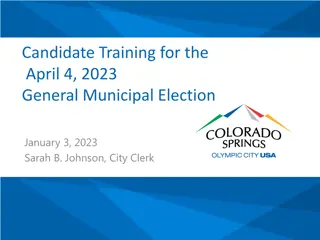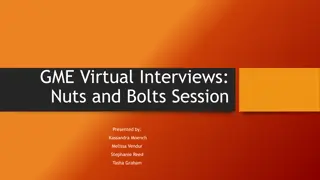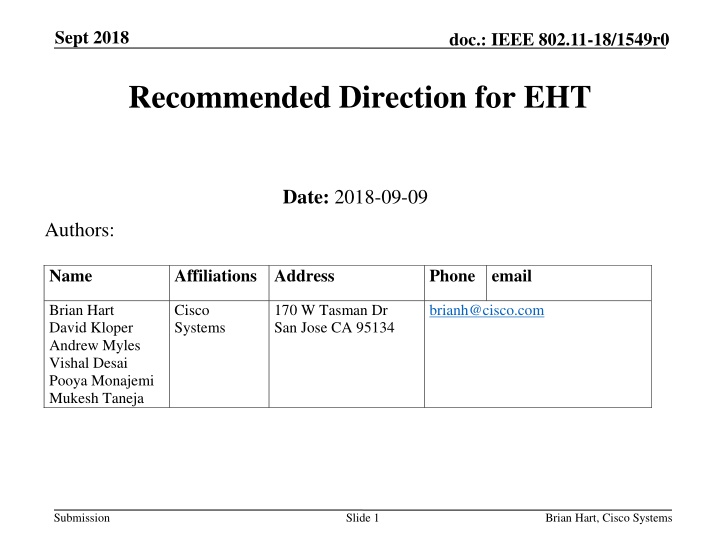
Key Features of IEEE 802.11 Standards Evolution
Explore the evolution of IEEE 802.11 standards with a focus on key features such as MIMO, MU-MIMO, OFDMA, and channel bandwidth. Understand the importance of channel allocation and bandwidth optimization in wireless deployments. Dive into the recommended directions for Enhanced High Throughput (EHT) and the right number of channels per band for optimal performance.
Download Presentation

Please find below an Image/Link to download the presentation.
The content on the website is provided AS IS for your information and personal use only. It may not be sold, licensed, or shared on other websites without obtaining consent from the author. If you encounter any issues during the download, it is possible that the publisher has removed the file from their server.
You are allowed to download the files provided on this website for personal or commercial use, subject to the condition that they are used lawfully. All files are the property of their respective owners.
The content on the website is provided AS IS for your information and personal use only. It may not be sold, licensed, or shared on other websites without obtaining consent from the author.
E N D
Presentation Transcript
Sept 2018 doc.: IEEE 802.11-18/1549r0 Recommended Direction for EHT Date: 2018-09-09 Authors: Name Affiliations Address Phone email Brian Hart David Kloper Andrew Myles Vishal Desai Pooya Monajemi Mukesh Taneja Cisco Systems 170 W Tasman Dr San Jose CA 95134 brianh@cisco.com Submission Slide 1 Brian Hart, Cisco Systems
Sept 2018 doc.: IEEE 802.11-18/1549r0 802.11 (+WFA) has a remarkable history of standardizing valuable technologies Amendment Mandatory Headline Feature Optional Headline Feature AP: 2SS MIMO AMPDU 11n (HT) 5 GHz 3-4SS 40 MHz Cumulative* 11ac (VHT) 5 GHz 40 MHz 80 MHz 3-8SS DL-MU-MIMO 160 MHz 256QAM 11ax (HE) 4SS AP: DL-MU-MIMO UL/DL-OFDMA MU-EDCA 3-8SS UL-MU-MIMO 160 MHz 256 & 1024QAM Some novel features jump straight to mandatory, and some evolve from optional to mandatory *With some minor exceptions: 5GHz not mandatory in 11ax but eco-system direction now well-established Exception for IoT-class 20MHz-only HE STAs Submission Slide 2 Brian Hart, Cisco Systems
Sept 2018 doc.: IEEE 802.11-18/1549r0 EHT Should Follow that Successful Path, with the Following Headline Features Amendment Mandatory Optional 11ax (HE) 4SS AP: DL-MU-MIMO UL/DL-OFDMA MU-EDCA 3-8SS UL-MU-MIMO 160 MHz 256 & 1024QAM Cumulative* 6 GHz Multiband 80+80 MHz 4SS AP: UL-MU-MIMO Non-AP: UL/DL Simul MU- MIMO + OFDMA 160 MHz HARQ Explicit sounding to 16SS Implicit sounding Low throughput PHY EHT 3-16SS 320 MHz, 80+160 MHz 256QAM, 1024QAM Why these features? See following slides Submission Slide 3 Brian Hart, Cisco Systems
Sept 2018 doc.: IEEE 802.11-18/1549r0 9.6 Channels Per Band is the Right Number Considering 320 MHz As a Mandatory Headline Feature[1-3,5,7,8,10] Some enterprise customers share their WLAN configs with their vendor for help on optimizing / troubleshooting their deployments Anonymous data from one vendor database of >30k configs and >900k 160MHz capable APs across 6 countries indicates: 160MHz (1-2ch@160 + 1ch@80M) 20MHz (13-25ch) 40MHz (6-12ch) 80MHz (3-5ch) 2GHz (11ad, 3-4ch) Manual Auto Human Expert selection 25% + 64% + 11% 0.02% + 0% + + Human + SW Expert selection 23% 59% 17% 0.02% 0% Geometric mean of #ch ranges from 5.6 to 13 with 9.6ch as the Take-aways: Highest data rates enabled by widest bandwidths are not the driving factor 2-3 channels is certainly too few channels; 3-5 channels is little favored too The mean of the preferred number of channels per deployment is 9.6 mean Submission Slide 4 Brian Hart, Cisco Systems
Sept 2018 doc.: IEEE 802.11-18/1549r0 so 320 MHz Doesn t Make Sense As a Mandatory Headline Feature, but 160 MHz Could Be When 11ac added 160 MHz, it needed new spectrum to make sense: 11ac anticipated access to 5.35-5.47 GHz and 5.875-5.925 GHz, yielding 775 MHz of contiguous spectrum, and 3ch@160 + 3ch@80 MHz That spectrum didn t eventuate, and 2ch@160 + 1-2ch@80M isn t viable [slide-1] There is much 11a/n/ac/ax legacy that supports 5 GHz but not 6 GHz Then 6 GHz cannot be considered more 5 GHz channels Instead 6 GHz is a third band, and must either be aggregated with 5 GHz or have sufficient channels 6-7.125 GHz opens up: 7 new 160 MHz channels, which is close to the industry sweet spot 3ch@320M + 1ch@160M, which is much below the industry sweet spot Strongly points to 320 MHz being a little used feature, and then optional Also 320MHz on an AP will severely impact power and size until a major process node shrink But 160 MHz makes enough sense for it to be mandatory And also non-contiguous 20/40/80M@5GHz + 20/40/80/160M@6GHz is very interesting Open up 2.3 GHz, and let s talk Submission Slide 5 Brian Hart, Cisco Systems
Sept 2018 doc.: IEEE 802.11-18/1549r0 16SS will Only Affect a Subset of Customers Considering 16SS As a Mandatory Headline Feature[1-3,5,7-10] Ultra hi end AP 16 Key: Max spatial streams Very hi end AP 8 8 Hi end AP 4 4 4 Lo end AP, hi end client 2-3 2-3 2-3 2-3 Mobile hotspot (1-2), Lo end client 1 1 1 1 1 2011 2007 2000+ 2019? 2024? Vendors progressively add antennas to APs, at a regular cadence Which is highly dependent on process node (and, closely related, power consumption and cost) There continues to be a range of products, and the highest number of antennas are only found on the premium products Based on historical patterns, 16SS is a 2024 technology Submission Slide 6 Brian Hart, Cisco Systems
Sept 2018 doc.: IEEE 802.11-18/1549r0 so 16SS MHz Doesn t Make Sense As a Mandatory Headline Feature, but Should Be Optional; And Needs Complementary Features Aggressive MU needed for efficiency Since there are negligible 4+SS clients, this mandates UL+DL MU-MIMO STA support And practically simul OFDMA+MU-MIMO too, given likely adoption of 160 MHz Sounding overheads increase 2x wrt 8SS: we need to bound the sounding overhead in order to achieve real gains: Continue explicit sounding but also add implicit sounding Let s assume that the AP performs self calibration (avoid the 11n complexity) AP can compel non-AP STAs to transmit efficient implicit sounding on demand Requested via a field in the Trigger frame The STA shall add Extension LTFs / midamble / postamble / other that sounds all TX antennas, at the triggered bandwidth If a STA has RX antennas not associated with a soundable TX antenna, then the STA shall be able to detect and tolerate MU interference on the unsounded RX antennas M D P U P a d MU-RTS CTS BAs Preamble Submission Slide 7 Brian Hart, Cisco Systems
Sept 2018 doc.: IEEE 802.11-18/1549r0 But this style of thinking is a bit of a trap, because the overarching datum is Customers want reliability and more client devices/AP Higher speeds are secondary Submission Slide 8 Brian Hart, Cisco Systems
Sept 2018 doc.: IEEE 802.11-18/1549r0 Obstacles to Higher Reliability ISM users (microwave ovens, hoppers, etc) Contention and collisions from 802.11 STAs, due to Active scanning Pre-11ax non-AP STAs that cannot be changed 11ax STAs transmitting SU PPDUs Mitigated via MU EDCA parameters, BSR polling, and random access RUs Contention between APs Less impactful, and more feasible to address A (partially) clean-sheet design for 6 GHz avoids some of this and can significantly mitigate the rest Recall, unlicensed spectrum means we re stuck with original choices for 20 years. We should revisit our implicit and explicit design choices to decide if they re right for 6 GHz for the next 20 years Submission Slide 9 Brian Hart, Cisco Systems
Sept 2018 doc.: IEEE 802.11-18/1549r0 Moreover, We re Missing a Mandatory Headline Feature Mandatory 6 GHz will be Most Impactful Adding 211% more channel bandwidth triples system capacity (3+25)=28x 20MHz channels today, plus 59x 20MHz channels This, more than anything, is the most impactful way to improve 802.11 customer experience and we should spend it wisely 802.11ac was a 5 GHz only standard, and ushered in widespread adoption of 5 GHz After 10 years of laggardly 5 GHz adoption EHT should do the same thing for 6 GHz Mandatory 6 GHz proliferates 802.11 in that band, and quickly By comparison, 802.11 did not embrace 3.5 GHz, and that is now a de facto cellular band An early and widespread 802.11 presence maintains practical access to the band Submission Slide 10 Brian Hart, Cisco Systems
Sept 2018 doc.: IEEE 802.11-18/1549r0 Multi-band Integrates 6 GHz into Existing Networks With Options for Reliability or Peak Data Rate[3-5,7,11] Classic concurrent multi-band BSSs No increase in peak data rate Beacons sent on each bands, with dual primaries Legacy STAs use the 5 GHz primary (EHT) STAs steered akin to ROMI parking; STAs needing highest QoS steered to 6 GHz primary APs send MU and solicit TB PPDUs that are non- contiguous across two bands for higher data rates 20/40/80/160MHz@5GHz + 20/40/80/160MHz@6GHz AP/non-AP STA PPDU requirements are: M: Contiguous: TX, RX M: Non-contiguous dual band: TX+TX, TX1+TX2, RX+RX, RX1+RX2 i.e. non-AP STAs can TX or RX on both bands simultaneously HD HD HD Standalone BSS at 2.4 GHz Standalone BSS at 5 GHz Standalone BSS at 6 GHz HD Double Headed HD AP Standalone BSS P40/80M; NonContig 40/80M@5G+80/160M@6G Standalone BSS at 2.4 GHz Standalone BSS P40/80M; NonContig 40/80M@5G+80/160M@6G HD Non-contiguous HD + FDD BSS at 5/6 GHz with independent contention at 5/6 GHz BSS at 5/6 GHz with independent contention at 5/6 GHz Standalone BSS at 2.4 GHz Optional: Same as Double Headed HD AP but now the AP and some STAs support frequency- division duplex O: FDD: TX1+RX2, RX1+TX2 For lower latency communications Natural extension to 2.4GHz but secondary importance Submission Slide 11 Brian Hart, Cisco Systems
Sept 2018 doc.: IEEE 802.11-18/1549r0 Clean-sheet 6 GHz Design (1/2)[5-7] First issue: 11ax is permitting 6 GHz usage already: at 11ax we propose to encourage 11ax towards: Preclude HT/VHT PHY formats at 6 GHz, no active scanning at 6GHz An 11ax AP at 6GHz must vacate a channel upon request by a cochannel neighboring EHT AP Otherwise EHT has no ability to make a clean-sheet design Actively probing when there are 59 channels is suboptimal. Hurts QoS and burdensome for non-AP STAs a) Mandate every 6 GHz AP has a colocated or nearby companion 2.4/5 GHz AP or an application-specific discovery mechanism, b) mandate neighbor reports with TSF offset across bands to help with discovery, c) prohibit active scanning at 6 GHz Also, more frequent mini-Beacons and Multi-channel Beacons to help with passive scanning Multichannel Beacon = FDM of 20 MHz PPDUs, with Beacon sent on P20 and Broadcast Probe Response that includes the channel number of P20 sent on the other 20MHz subchannels; with power allocation to minimize range loss of the Beacon E.g. 10% of power E.g. 10% of power E.g. 70% of power E.g. 10% of power Broadcast Probe response (P20=5) ch13 ch9 ch5 ch1 Broadcast Probe response (P20=5) Beacon Broadcast Probe response (P20=5) Submission Slide 12 Brian Hart, Cisco Systems
Sept 2018 doc.: IEEE 802.11-18/1549r0 Clean-sheet 6 GHz Design (2/2) Should we disallow 20 MHz channels? Some loss of Beacon range Some loss with nearby Primary spectrum services, since we lose spectrum in 40 MHz chunks Should we redefine a TU to be 1000us at 6 GHz, to assist with coexistence with other technologies? We lean against too awkward for 802.11, but the question bears raising Should we prevent contention by non-AP STAs? Exclusively use random access RUs, TWT, BSR polling, MU/TB PPDUs instead Should we add EVM in every CTS/Ack/BA frame / PPDU? Built-in rather than a Control Wrapper Should we replace 11a format by a Low Throughput PHY format Next 2 slides Submission Slide 13 Brian Hart, Cisco Systems
Sept 2018 doc.: IEEE 802.11-18/1549r0 Issues with 11a in 6 GHz Bandwidth indication is a kludge Doesn t easily extend to 320MHz Never addressed non-contiguous Doesn t support higher MCSs, wider bandwidths or LDPC Duplication at end of TXOP to avoid EIFS is inefficient No future proofing E.g. no ability to insert an EVM But EHT at 6 GHz still needs something for control frames and short data frames Submission Slide 14 Brian Hart, Cisco Systems
Sept 2018 doc.: IEEE 802.11-18/1549r0 Low Throughput (LT) PHY Design LSTF LLTF LTSIG Dup Data field LSTF LLTF LTSIG LSTF LLTF LTSIG Dup Data field LSTF LLTF LTSIG Data field LSTF LLTF LTSIG Dup Data field LSTF LLTF LTSIG LSTF LLTF LTSIG Dup Data field LSTF LLTF LTSIG Summary: Synthesis of: 11a: limited to 1SS max, no xSTF, xLTF nor SIGB HTGF: 90deg rot at LTSIG HE: extra training around LTSIG (deferred from LLTF so preamble processing common for 20M and >20M) Mandatory in 6GHz, replaces 11a PHY; prohibited in 2.4/5 GHz 48-56 LTSIG bits via 2 OFDM symbols or 40MHz raster (TBD) 8b CRC in LTSIG, 14-18b reserved bits available for future growth Fixed XOR mask in place of scrambler due to high count of reserved bits MCS predefined up to 64KQAM BW predefined up to 2560 MHz; could indicate non-contiguous too Data field can be duplicated (RTS/CTS) or not (Ack/BA/short data/short mgmt.). Add a LTSIG bit Last PPDU in TXOP in lieu of duplicated-20MHz Ack/BA to avoid EIFS Submission Slide 15 Brian Hart, Cisco Systems
Sept 2018 doc.: IEEE 802.11-18/1549r0 HARQ[2,5,6] Promising direction for 802.11, targeted directly at increased reliability Unlicensed noise model is collision-dominated, with uncontrolled and highly variable interference power per PPDU Not noise or controlled interference Have to avoid averaging good + trashed soft bits Often unclear when a PPDU is even directed to a STA Therefore we should limit HARQ to positively identified PPDUs Recommend that HARQ only be allowed when the TA is predictable: i.e. MU/TB PPDUs Then AP knows own limitations, so only non-AP STAs negotiate buffer depth, etc Submission Slide 16 Brian Hart, Cisco Systems
Sept 2018 doc.: IEEE 802.11-18/1549r0 Misc We always see demand for the following, which should be permitted by the PAR: Client power saving Coexistence / regulatory Submission Slide 17 Brian Hart, Cisco Systems
Sept 2018 doc.: IEEE 802.11-18/1549r0 Summary Amendment Mandatory Optional EHT 6 GHz Multiband 80+80 MHz 4SS AP: UL-MU-MIMO Non-AP: UL/DL Simul MU- MIMO + OFDMA 160 MHz HARQ Explicit sounding to 16SS Implicit sounding Low throughput PHY 3-16SS 320 MHz, 80+160 MHz 256QAM, 1024QAM Submission Slide 18 Brian Hart, Cisco Systems
Sept 2018 doc.: IEEE 802.11-18/1549r0 References [1] 11-18-0789-10-0wng-extreme-throughput-802-11 [2] 11-18-1116-00-0eht-multi-ap-harq-for-eht (1) [3] 11-18-1155-01-0eht-multi-ap-enhancement-and-multi-band-operations [4] 11-18-1161-00-0eht-eht-technology-candidate-discussions [5] 11-18-1171-00-0eht-view-on-eht-objectives-and-technologies [6] 11-18-1180-00-0eht-discussion-on-eht-study-group-formation [7] 11-18-1184-01-0eht-eht-discussions-on-throughput-enhancement [8] 11-18-1190-01-0eht-discussion-on-eht-timeline-and-scope [9] 11-18-1191-00-0eht-mu-sounding-improvements [10] 11-18-1263-03-0eht-eht-subgroup-formation-motion [11] 11-18-1271-00-0eht-eht-802-11-study-group-creation [12] 11-18-1316-02-0eht-eht-802-11-way-forward ; Submission Slide 19 Brian Hart, Cisco Systems

